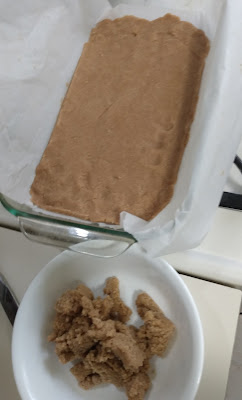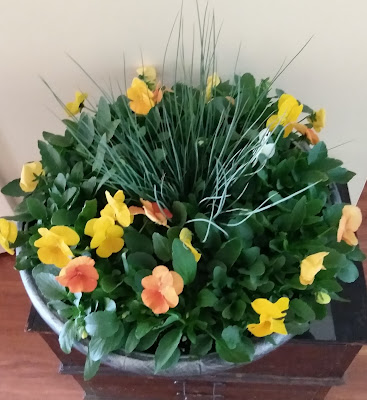Sudden discovery of a total lack of soup in the house led to a pivot in plans for lunch. So since I did have broccoli, mushrooms, onions and feta cheese, that seemed like a good idea. It's about the same filling as I used for my spanakopita, but since I had no spinach, this is broccokopita, and pretty good, too.
Here's the broccoli steaming gently, and the onions and mushrooms in oil and butter and smelling really good. In the background the dough is resting for 20 minutes, supposed to be an hour, but I didn't think of this in time.
And the feta cheese, crumbled and ready for the mixture
Here are the six bits of dough, each enough to make a large pasty, and the bench scraper I used to cut them.
I saved out one for today, then froze the other five, floured, in a piece of plastic, the whole folded and slid into a bag which Chris will recognize, knowing that nothing at all goes to waste around here. The original contents, in the inner bag they came in, the masa harina, that is, in the freezer, still some left for another corn tortilla caper. And there's a container of today's filling now in the freezer, so I have five lunch kits ready to go.
This is a byway into the kind of baking pan I like very much when I can remember to get it out and use it. It was more expensive than my usual supermarket ware, because it has a double bottom, with a kind of air cushion inside. This makes it bake evenly, and anything you make gets beautifully brown, see below
Wrong way up, but see how nicely it browned
Right way up, ready for action, garnished with Thai basil.
And, full disclosure, my DNA over came me as it does once in a while, and I was overwhelmed last evening with the need to make pink blancmange. Pronounced blomonj where I come from, it's a cornstarch, milk, vanilla, sugar thing not always beloved of little English kids, but nonetheless forced on them when too young to protest.
Before I leave the enthralling subject of kitchenware, someone now and then asks about seasoning cast iron ware. I did the full monty of baking with oil, all that, years ago when I first got them, but since then just swipe around them after cooking in them, and brush a bit of olive oil on. That's it.
Except today, when the onions and mushrooms made their presence felt, and there was a bit of debris which would not mix well next time I make cornbread. So I scrubbed with oil and kosher salt until it was all smooth again, rinsed it rapidly under the cold tap, then set it on a hot burner to dry out completely. Spritz of oil after that, and you're done. What make them rust is if you forget to get them completely dry before you put them away. There, worth every penny you paid for the advice.
Then the mitered knitting stuff redux.
I did four squares, and picked up stitches to attach them, all pretty much according to the pattern. Which I then abandoned, because I realized not only that picking up stitches is more tedious than sewing parts together, the other option, and that the design idea was too rigid for my likes.
I'd rather make a lot of squares then arrange them pleasingly into a design and then attach them together. So that's what I'm doing. Also this means that your current work is very portable, another good point. Carrying one little square around beats carrying an every increasing blankie thing.
And this is what I went to the library to pick up this morning, and very good indeed it is. I've barely begun to read it, but I can see this is good. Not only very historically accurate and illustrated well, but funny as all getout, too. And it has footnotes and a bibliography, which I'm definitely going to mine for more reading.
I've read a number of Lurie novels, haven't we all, but I wasn't familiar with this book. Highly recommended to anyone who likes fashion, social history, wit, anecdotes and great old photography, or all of the above.
Ginger Rogers, conspicuous theatrical consumption
And this little kid in grown up clothes, I remember seeing this sometimes in Wisconsin in the early 60s when we first came here, and was astonished. Mainly I think it was going to church wear. This picture is from the 50s, note the New Look influence on the mother's silhouette and skirt length. The little boy doesn't look too happy about his suit and cap. And while we're there, get his mother's platform t-straps! She must have had great balance to manage them.
And here's a late nineteenth century demonstration of the influence of Japanese design on western fashion and interior decor. Then thought of as fashionable, now considered at best appropriation, at worst, theft of cultural capital.
And the New Yorker got into the act of examining the meaning and cultural weight of clothes for men. Speaking of which, there are New Yorker cartoons here and there in the book, which speak to the fact that you can only really get New Yorker cartoons if you are familiar with the context. Which she explains in her text, anyway.
Just see if you can get this book. It's old now, over 40 years, and may not be so easy to acquire, but if you like this sort of exploration, this is for you. It's certainly for me.


















































